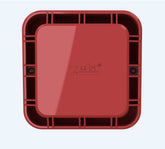When it comes to fire protection systems, FM-200® (also known as HFC-227ea) is one of the most trusted clean agent fire suppression solutions around the world. It's widely used in data centers, telecommunication facilities, hospitals, museums, and other sensitive areas where traditional water-based systems could cause more harm than good.
But one common question that arises is: Is FM-200 safe for humans?
Let’s dive into the details.
What Is FM-200?
FM-200 is a colorless, odorless, non-conductive gas that suppresses fires quickly by absorbing heat. Unlike water or foam, FM-200 leaves no residue and requires no major clean-up after discharge. It’s designed to extinguish a fire in its early stages, often within seconds, minimizing damage and downtime.
Its chemical name is heptafluoropropane (C₃HF₇), and it’s stored as a liquid inside cylinders but discharged as a gas to fight fires.
Human Safety and FM-200
The good news is: FM-200 is considered safe for occupied spaces when used correctly.
The National Fire Protection Association (NFPA) — specifically NFPA 2001, the standard for clean agent fire suppression systems — has set guidelines for the safe use of FM-200. When designed and installed according to these standards, FM-200 concentrations are kept at levels that are effective against fires but still safe for human exposure.
Here’s what you need to know:
1. Short-Term Exposure
FM-200 systems are designed to discharge in an emergency and suppress a fire within seconds. Short-term exposure to FM-200 at the concentrations used for fire suppression is generally safe for people.
- No harmful residues are left behind.
- It doesn’t deplete oxygen levels significantly.
- It’s non-toxic at typical design concentrations.
In most cases, occupants can remain safely inside during discharge, but evacuation is still recommended after activation as a precaution.
2. Extended Exposure
While FM-200 is safe for short exposure during a system discharge, longer-term exposure or exposure at higher-than-recommended concentrations could cause:
- Dizziness
- Headaches
- Nausea
Therefore, fire protection designs ensure that the concentration levels used are low enough to avoid these issues and that occupants evacuate shortly after the system activates.
3. Temperature and Decomposition Risks
At very high temperatures (for example, if FM-200 is exposed to open flames for extended periods), it can break down and form byproducts like hydrogen fluoride (HF), which can be harmful. However, FM-200 systems are designed to suppress fires before significant decomposition occurs, making this risk extremely low in practice.
Key Safety Guidelines
To ensure FM-200 remains safe for humans:
- Systems must be designed by certified professionals following NFPA 2001 guidelines.
- Proper signage should indicate the presence of a clean agent system.
- Personnel should be trained on what to do in case of a system discharge.
- Rooms should have evacuation alarms triggered by the system.
Conclusion: Safe, When Used Correctly
In summary, FM-200 is safe for humans when properly designed, installed, and maintained. It provides fast, effective fire suppression without the water damage that traditional sprinkler systems can cause.
However, like any fire suppression agent, evacuation after a discharge is always the safest course of action.
If you’re considering installing an FM-200 system for your facility, make sure you work with experienced fire protection professionals who follow international safety standards. Protecting your people and your assets — without risking harm — should always be the top priority.
Need Help with FM-200 Systems?
Our team at Turxin Engineering Limited specializes in the design, installation, and maintenance of FM-200 systems, ensuring both fire protection and human safety are our priorities. Contact us today for a free consultation!









 Whatsapp Us!
Whatsapp Us!